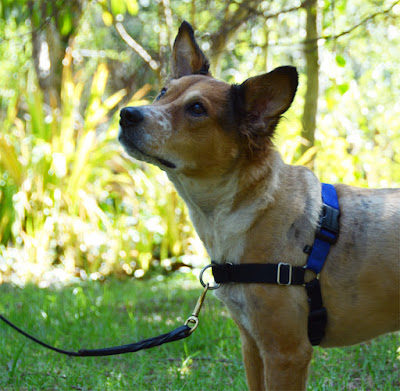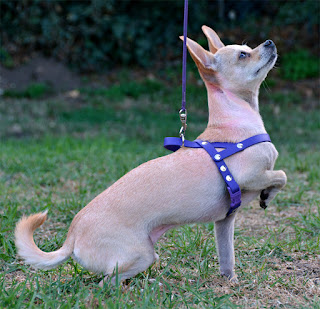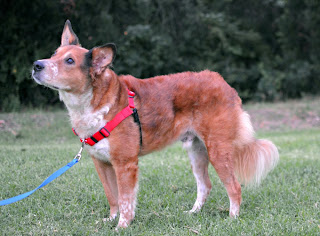
Just make the straps that go around the bottom and top tight enough that they remain in a straight vertical line even when the front strap is pulled forward. Then adjust the front strap so that it is tight enough to stay horizontal, 90 degrees from the other two straps, but not so tight that it pulls them forward. The connector rings and front strap should sit precisely at the level of the dog's breastbone. Easy, right?
The Mythical T-Shape
It sounds easy until you actually try to put an Easy Walk harness on a dog. Then physics comes into play and you begin to realize that dogs aren't shaped like that. I have yet to find a dog on which I could fit an Easy Walk harness as directed. No matter how incredibly dog-suffocatingly tight I make those top and bottom straps, they will not remain vertical. Nope. Not happening. Also, the straps attach to each other via a ring on either side. This allows the straps to rotate freely out of position at the slightest pressure.
 |
| If your harness fits like this and any of the straps are at their maximum length, you probably need a bigger harness. Photo by Erin Koski |
The front strap on the Premier PetSafe EasyWalk harness includes a martingale loop that allows it to tighten. This feature also makes it very heavy. Unless your dog has an extremely prominent breastbone on which to hang that strap, it is going to sag. Heavy leash clips exacerbate this issue, and once again those handy side rings allow it to rotate very easily. There is no keeping the front strap horizontal.
So what can you do? If you try to keep the front strap tight enough to stay up, it pulls the top and bottom straps out of vertical and into the NO Y-shape. If you try to keep the top and bottom straps vertical, the front strap sags. There is no happy medium. Even worse, the mythical T-shape requires that the top and bottom straps sit in your dog's armpits, and fit very tightly. Chafed underarms galore.
The SENSE-ible Solution
The fitting instructions for the SENSE-ation harness are a bit different, but they work extremely well for the EasyWalk. For a better, more comfortable, less droopy fit, loosen that bottom strap and tighten up the top one a bit. The connector rings should now sit higher than the dog's breastbone.
 |
| A size bigger, this M/L can be adjusted for a better fit. Photo by Erin Koski |
With the front strap now attached a bit higher, it should sag right into its ideal position. When light pressure is applied, the Easy Walk harness may even take on the mythical T-shape. Since the front is no longer being held in place purely by tension, the bottom strap can be loosened enough to allow some freedom of movement. This also keeps it out of the dog's armpits and reduces chafing.
How to Fit an Easy Walk Harness Comfortably
1. Find the point of the dog's breastbone at the front of their chest, just below their neck.
2. Adjust the top shoulder strap so that the connector rings on either side sit an inch or two above this point.
3. Adjust the bottom belly strap so that it is snug, but loose enough to allow the dog to sit comfortably without getting jabbed in the armpits.
4. Adjust the front chest strap so it is snug enough to sit against the dog's body, but not so tight as the affect the position of the other two straps. It should droop slightly and sit just at the dog's breastbone.
5. If the front chest straps hangs lower than the breastbone or the leash clasp hits the dog's legs, tighten the top shoulder strap more. If the bottom belly strap is chafing under the front legs, loosen the front chest strap and tighten the top shoulder strap.
Keep in mind that Easy Walk harnesses tend to loosen up over time, and need to be tightened and adjusted often. Have you used this harness? How well did it work for you?









































